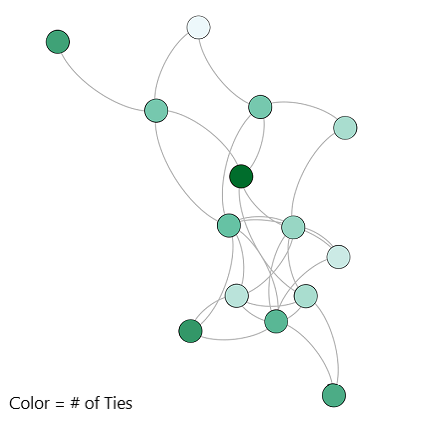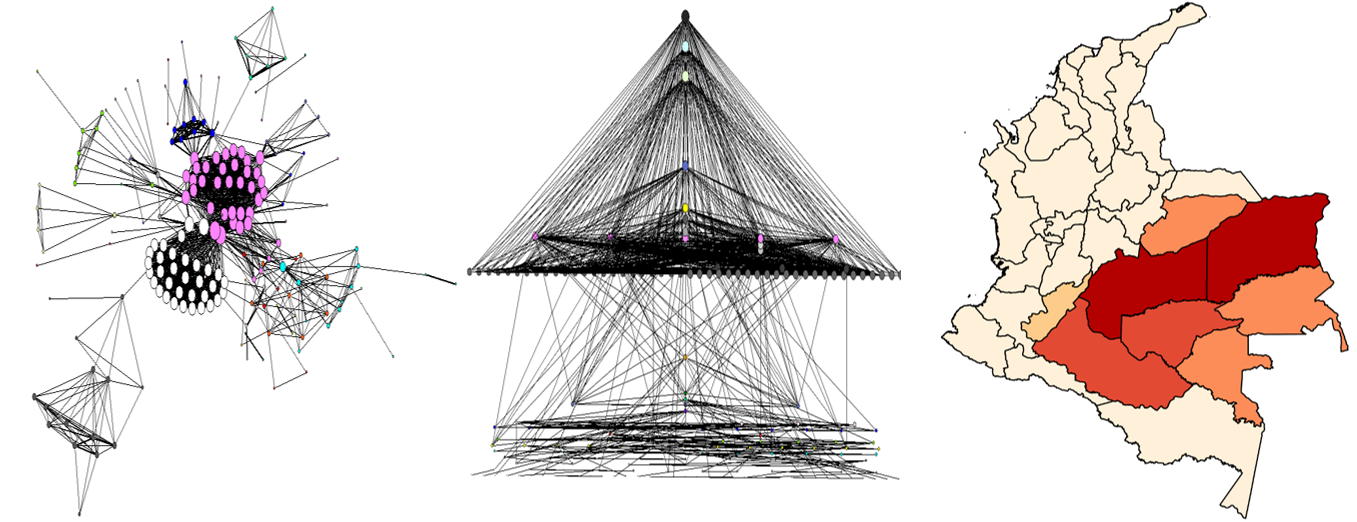class: center, middle, inverse, title-slide # Data Visualization ## CORE Lab ### Department of Defense Analysis ### 2019-08-08 --- # Introduction * Purpose * Scope * Data visualization in R --- # Why visualize data? * Leverage capabilities and bandwidth of visual system to move information (often huge amounts) into the brain quickly. -- * Amplifies cognition in several ways (Card et al., 1999): * Increase cognitive resources * Reduce search * Enhance recognition of patterns and outliers * Support inferences of relationships * Can provide a medium with which to interact -- * We think visually. --- # Close Personal Network <div id="htmlwidget-20717b0264ab97860743" style="width:504px;height:504px;" class="visNetwork html-widget"></div> <script type="application/json" data-for="htmlwidget-20717b0264ab97860743">{"x":{"nodes":{"id":["You","Family 1","Family 2","Family 3","Family 4"],"type":["You","Family","Family","Family","Family"],"title":["<b>Name: <\/b> You <br> <b>Type: <\/b> You <br>","<b>Name: <\/b> Family 1 <br> <b>Type: <\/b> Family <br>","<b>Name: <\/b> Family 2 <br> <b>Type: <\/b> Family <br>","<b>Name: <\/b> Family 3 <br> <b>Type: <\/b> Family <br>","<b>Name: <\/b> Family 4 <br> <b>Type: <\/b> Family <br>"],"color":["#7fc97f","#beaed4","#beaed4","#beaed4","#beaed4"],"label":["You","Family 1","Family 2","Family 3","Family 4"]},"edges":{"from":["You","You","You","You"],"to":["Family 1","Family 2","Family 3","Family 4"],"relationship":["Family ","Family ","Family ","Family "]},"nodesToDataframe":true,"edgesToDataframe":true,"options":{"width":"100%","height":"100%","nodes":{"shape":"dot"},"manipulation":{"enabled":false},"edges":{"smooth":false},"physics":{"solver":"forceAtlas2Based","stabilization":false,"enabled":true},"interaction":{"hover":true,"dragNodes":true,"dragView":true,"keyboard":true,"navigationButtons":true,"zoomView":true}},"groups":null,"width":null,"height":null,"idselection":{"enabled":false,"style":"width: 150px; height: 26px","useLabels":true,"main":"Select by id"},"byselection":{"enabled":true,"style":"width: 150px; height: 26px","multiple":false,"hideColor":"rgba(200,200,200,0.5)","variable":"id","main":"Select by id","values":["Family 1","Family 2","Family 3","Family 4","You"]},"main":null,"submain":null,"footer":null,"background":"rgba(0, 0, 0, 0)","highlight":{"enabled":true,"hoverNearest":true,"degree":1,"algorithm":"all","hideColor":"rgba(200,200,200,0.5)","labelOnly":true},"collapse":{"enabled":false,"fit":false,"resetHighlight":true,"clusterOptions":null,"keepCoord":true,"labelSuffix":"(cluster)"},"tooltipStay":300,"tooltipStyle":"position: fixed;visibility:hidden;padding: 5px;white-space: nowrap;font-family: verdana;font-size:14px;font-color:#000000;background-color: #f5f4ed;-moz-border-radius: 3px;-webkit-border-radius: 3px;border-radius: 3px;border: 1px solid #808074;box-shadow: 3px 3px 10px rgba(0, 0, 0, 0.2);"},"evals":[],"jsHooks":[]}</script> --- # Close Personal Network <div id="htmlwidget-05bbdfa06c177090d61e" style="width:504px;height:504px;" class="visNetwork html-widget"></div> <script type="application/json" data-for="htmlwidget-05bbdfa06c177090d61e">{"x":{"nodes":{"id":["You","Family 1","Family 2","Family 3","Family 4"],"type":["You","Family","Family","Family","Family"],"title":["<b>Name: <\/b> You <br> <b>Type: <\/b> You <br>","<b>Name: <\/b> Family 1 <br> <b>Type: <\/b> Family <br>","<b>Name: <\/b> Family 2 <br> <b>Type: <\/b> Family <br>","<b>Name: <\/b> Family 3 <br> <b>Type: <\/b> Family <br>","<b>Name: <\/b> Family 4 <br> <b>Type: <\/b> Family <br>"],"color":["#7fc97f","#beaed4","#beaed4","#beaed4","#beaed4"],"label":["You","Family 1","Family 2","Family 3","Family 4"]},"edges":{"from":["You","You","You","You","Family 1","Family 1","Family 3"],"to":["Family 1","Family 2","Family 3","Family 4","Family 2","Family 4","Family 2"],"relationship":["Family ","Family ","Family ","Family ","Between Family","Between Family","Between Family"]},"nodesToDataframe":true,"edgesToDataframe":true,"options":{"width":"100%","height":"100%","nodes":{"shape":"dot"},"manipulation":{"enabled":false},"edges":{"smooth":false},"physics":{"solver":"forceAtlas2Based","stabilization":false,"enabled":true},"interaction":{"hover":true,"dragNodes":true,"dragView":true,"keyboard":true,"navigationButtons":true,"zoomView":true}},"groups":null,"width":null,"height":null,"idselection":{"enabled":false,"style":"width: 150px; height: 26px","useLabels":true,"main":"Select by id"},"byselection":{"enabled":true,"style":"width: 150px; height: 26px","multiple":false,"hideColor":"rgba(200,200,200,0.5)","variable":"id","main":"Select by id","values":["Family 1","Family 2","Family 3","Family 4","You"]},"main":null,"submain":null,"footer":null,"background":"rgba(0, 0, 0, 0)","highlight":{"enabled":true,"hoverNearest":true,"degree":1,"algorithm":"all","hideColor":"rgba(200,200,200,0.5)","labelOnly":true},"collapse":{"enabled":false,"fit":false,"resetHighlight":true,"clusterOptions":null,"keepCoord":true,"labelSuffix":"(cluster)"},"tooltipStay":300,"tooltipStyle":"position: fixed;visibility:hidden;padding: 5px;white-space: nowrap;font-family: verdana;font-size:14px;font-color:#000000;background-color: #f5f4ed;-moz-border-radius: 3px;-webkit-border-radius: 3px;border-radius: 3px;border: 1px solid #808074;box-shadow: 3px 3px 10px rgba(0, 0, 0, 0.2);"},"evals":[],"jsHooks":[]}</script> --- # Close Personal Network <div id="htmlwidget-bb0b7ba978c23ee583a0" style="width:504px;height:504px;" class="visNetwork html-widget"></div> <script type="application/json" data-for="htmlwidget-bb0b7ba978c23ee583a0">{"x":{"nodes":{"id":["You","Family 1","Family 2","Family 3","Family 4","Friend 1","Friend 2","Friend 3","Friend 4"],"type":["You","Family","Family","Family","Family","Friend ","Friend ","Friend ","Friend "],"title":["<b>Name: <\/b> You <br> <b>Type: <\/b> You <br>","<b>Name: <\/b> Family 1 <br> <b>Type: <\/b> Family <br>","<b>Name: <\/b> Family 2 <br> <b>Type: <\/b> Family <br>","<b>Name: <\/b> Family 3 <br> <b>Type: <\/b> Family <br>","<b>Name: <\/b> Family 4 <br> <b>Type: <\/b> Family <br>","<b>Name: <\/b> Friend 1 <br> <b>Type: <\/b> Friend <br>","<b>Name: <\/b> Friend 2 <br> <b>Type: <\/b> Friend <br>","<b>Name: <\/b> Friend 3 <br> <b>Type: <\/b> Friend <br>","<b>Name: <\/b> Friend 4 <br> <b>Type: <\/b> Friend <br>"],"color":["#7fc97f","#beaed4","#beaed4","#beaed4","#beaed4",null,null,null,null],"label":["You","Family 1","Family 2","Family 3","Family 4","Friend 1","Friend 2","Friend 3","Friend 4"]},"edges":{"from":["You","You","You","You","Family 1","Family 1","Family 3","You","You","You","You"],"to":["Family 1","Family 2","Family 3","Family 4","Family 2","Family 4","Family 2","Friend 1","Friend 2","Friend 3","Friend 4"],"relationship":["Family ","Family ","Family ","Family ","Between Family","Between Family","Between Family","Friendship","Friendship","Friendship","Friendship"]},"nodesToDataframe":true,"edgesToDataframe":true,"options":{"width":"100%","height":"100%","nodes":{"shape":"dot"},"manipulation":{"enabled":false},"edges":{"smooth":false},"physics":{"solver":"forceAtlas2Based","stabilization":false,"enabled":true},"interaction":{"hover":true,"dragNodes":true,"dragView":true,"keyboard":true,"navigationButtons":true,"zoomView":true}},"groups":null,"width":null,"height":null,"idselection":{"enabled":false,"style":"width: 150px; height: 26px","useLabels":true,"main":"Select by id"},"byselection":{"enabled":true,"style":"width: 150px; height: 26px","multiple":false,"hideColor":"rgba(200,200,200,0.5)","variable":"id","main":"Select by id","values":["Family 1","Family 2","Family 3","Family 4","Friend 1","Friend 2","Friend 3","Friend 4","You"]},"main":null,"submain":null,"footer":null,"background":"rgba(0, 0, 0, 0)","highlight":{"enabled":true,"hoverNearest":true,"degree":1,"algorithm":"all","hideColor":"rgba(200,200,200,0.5)","labelOnly":true},"collapse":{"enabled":false,"fit":false,"resetHighlight":true,"clusterOptions":null,"keepCoord":true,"labelSuffix":"(cluster)"},"tooltipStay":300,"tooltipStyle":"position: fixed;visibility:hidden;padding: 5px;white-space: nowrap;font-family: verdana;font-size:14px;font-color:#000000;background-color: #f5f4ed;-moz-border-radius: 3px;-webkit-border-radius: 3px;border-radius: 3px;border: 1px solid #808074;box-shadow: 3px 3px 10px rgba(0, 0, 0, 0.2);"},"evals":[],"jsHooks":[]}</script> --- # Close Personal Network <div id="htmlwidget-3b809ca554a9de845f5b" style="width:504px;height:504px;" class="visNetwork html-widget"></div> <script type="application/json" data-for="htmlwidget-3b809ca554a9de845f5b">{"x":{"nodes":{"id":["You","Family 1","Family 2","Family 3","Family 4","Friend 1","Friend 2","Friend 3","Friend 4"],"type":["You","Family","Family","Family","Family","Friend ","Friend ","Friend ","Friend "],"title":["<b>Name: <\/b> You <br> <b>Type: <\/b> You <br>","<b>Name: <\/b> Family 1 <br> <b>Type: <\/b> Family <br>","<b>Name: <\/b> Family 2 <br> <b>Type: <\/b> Family <br>","<b>Name: <\/b> Family 3 <br> <b>Type: <\/b> Family <br>","<b>Name: <\/b> Family 4 <br> <b>Type: <\/b> Family <br>","<b>Name: <\/b> Friend 1 <br> <b>Type: <\/b> Friend <br>","<b>Name: <\/b> Friend 2 <br> <b>Type: <\/b> Friend <br>","<b>Name: <\/b> Friend 3 <br> <b>Type: <\/b> Friend <br>","<b>Name: <\/b> Friend 4 <br> <b>Type: <\/b> Friend <br>"],"color":["#7fc97f","#beaed4","#beaed4","#beaed4","#beaed4",null,null,null,null],"label":["You","Family 1","Family 2","Family 3","Family 4","Friend 1","Friend 2","Friend 3","Friend 4"]},"edges":{"from":["You","You","You","You","Family 1","Family 1","Family 3","You","You","You","You","Friend 1","Friend 2","Friend 2","Friend 3"],"to":["Family 1","Family 2","Family 3","Family 4","Family 2","Family 4","Family 2","Friend 1","Friend 2","Friend 3","Friend 4","Friend 3","Friend 4","Friend 1","Friend 4"],"relationship":["Family ","Family ","Family ","Family ","Between Family","Between Family","Between Family","Friendship","Friendship","Friendship","Friendship","Between Friend","Between Friend","Between Friend","Between Friend"]},"nodesToDataframe":true,"edgesToDataframe":true,"options":{"width":"100%","height":"100%","nodes":{"shape":"dot"},"manipulation":{"enabled":false},"edges":{"smooth":false},"physics":{"solver":"forceAtlas2Based","stabilization":false,"enabled":true},"interaction":{"hover":true,"dragNodes":true,"dragView":true,"keyboard":true,"navigationButtons":true,"zoomView":true}},"groups":null,"width":null,"height":null,"idselection":{"enabled":false,"style":"width: 150px; height: 26px","useLabels":true,"main":"Select by id"},"byselection":{"enabled":true,"style":"width: 150px; height: 26px","multiple":false,"hideColor":"rgba(200,200,200,0.5)","variable":"id","main":"Select by id","values":["Family 1","Family 2","Family 3","Family 4","Friend 1","Friend 2","Friend 3","Friend 4","You"]},"main":null,"submain":null,"footer":null,"background":"rgba(0, 0, 0, 0)","highlight":{"enabled":true,"hoverNearest":true,"degree":1,"algorithm":"all","hideColor":"rgba(200,200,200,0.5)","labelOnly":true},"collapse":{"enabled":false,"fit":false,"resetHighlight":true,"clusterOptions":null,"keepCoord":true,"labelSuffix":"(cluster)"},"tooltipStay":300,"tooltipStyle":"position: fixed;visibility:hidden;padding: 5px;white-space: nowrap;font-family: verdana;font-size:14px;font-color:#000000;background-color: #f5f4ed;-moz-border-radius: 3px;-webkit-border-radius: 3px;border-radius: 3px;border: 1px solid #808074;box-shadow: 3px 3px 10px rgba(0, 0, 0, 0.2);"},"evals":[],"jsHooks":[]}</script> --- # Close Personal Network <div id="htmlwidget-3bfe0f1b8e67339cccb4" style="width:504px;height:504px;" class="visNetwork html-widget"></div> <script type="application/json" data-for="htmlwidget-3bfe0f1b8e67339cccb4">{"x":{"nodes":{"id":["You","Family 1","Family 2","Family 3","Family 4","Friend 1","Friend 2","Friend 3","Friend 4"],"type":["You","Family","Family","Family","Family","Friend ","Friend ","Friend ","Friend "],"title":["<b>Name: <\/b> You <br> <b>Type: <\/b> You <br>","<b>Name: <\/b> Family 1 <br> <b>Type: <\/b> Family <br>","<b>Name: <\/b> Family 2 <br> <b>Type: <\/b> Family <br>","<b>Name: <\/b> Family 3 <br> <b>Type: <\/b> Family <br>","<b>Name: <\/b> Family 4 <br> <b>Type: <\/b> Family <br>","<b>Name: <\/b> Friend 1 <br> <b>Type: <\/b> Friend <br>","<b>Name: <\/b> Friend 2 <br> <b>Type: <\/b> Friend <br>","<b>Name: <\/b> Friend 3 <br> <b>Type: <\/b> Friend <br>","<b>Name: <\/b> Friend 4 <br> <b>Type: <\/b> Friend <br>"],"color":["#7fc97f","#beaed4","#beaed4","#beaed4","#beaed4",null,null,null,null],"label":["You","Family 1","Family 2","Family 3","Family 4","Friend 1","Friend 2","Friend 3","Friend 4"]},"edges":{"from":["You","You","You","You","Family 1","Family 1","Family 3","You","You","You","You","Friend 1","Friend 2","Friend 2","Friend 3","Family 1","Family 2","Family 2","Family 3"],"to":["Family 1","Family 2","Family 3","Family 4","Family 2","Family 4","Family 2","Friend 1","Friend 2","Friend 3","Friend 4","Friend 3","Friend 4","Friend 1","Friend 4","Friend 2","Friend 2","Friend 3","Friend 1"],"relationship":["Family ","Family ","Family ","Family ","Between Family","Between Family","Between Family","Friendship","Friendship","Friendship","Friendship","Between Friend","Between Friend","Between Friend","Between Friend","Friend-Fam","Friend-Fam","Friend-Fam","Friend-Fam"]},"nodesToDataframe":true,"edgesToDataframe":true,"options":{"width":"100%","height":"100%","nodes":{"shape":"dot"},"manipulation":{"enabled":false},"edges":{"smooth":false},"physics":{"solver":"forceAtlas2Based","stabilization":false,"enabled":true},"interaction":{"hover":true,"dragNodes":true,"dragView":true,"keyboard":true,"navigationButtons":true,"zoomView":true}},"groups":null,"width":null,"height":null,"idselection":{"enabled":false,"style":"width: 150px; height: 26px","useLabels":true,"main":"Select by id"},"byselection":{"enabled":true,"style":"width: 150px; height: 26px","multiple":false,"hideColor":"rgba(200,200,200,0.5)","variable":"id","main":"Select by id","values":["Family 1","Family 2","Family 3","Family 4","Friend 1","Friend 2","Friend 3","Friend 4","You"]},"main":null,"submain":null,"footer":null,"background":"rgba(0, 0, 0, 0)","highlight":{"enabled":true,"hoverNearest":true,"degree":1,"algorithm":"all","hideColor":"rgba(200,200,200,0.5)","labelOnly":true},"collapse":{"enabled":false,"fit":false,"resetHighlight":true,"clusterOptions":null,"keepCoord":true,"labelSuffix":"(cluster)"},"tooltipStay":300,"tooltipStyle":"position: fixed;visibility:hidden;padding: 5px;white-space: nowrap;font-family: verdana;font-size:14px;font-color:#000000;background-color: #f5f4ed;-moz-border-radius: 3px;-webkit-border-radius: 3px;border-radius: 3px;border: 1px solid #808074;box-shadow: 3px 3px 10px rgba(0, 0, 0, 0.2);"},"evals":[],"jsHooks":[]}</script> --- # Common Mistakes * **Inappropriate use of visual cues/properties** * Too many dimensions * Lack of context * Attempting to substitute visual appeal for substance * Accidentially misleading audience * Quality of underlying data --- # Inappropriate use of visual properties .center[ ] --- # Common Mistakes * Inappropriate use of visual cues/properties * **Too many dimensions** * Lack of context * Attempting to substitute visual appeal for substance * Accidentially misleading audience * Quality of underlying data --- # Too many dimensions .center[ ] --- # Common Mistakes * Inappropriate use of visual cues/properties * Too many dimensions * **Lack of context** * Attempting to substitute visual appeal for substance * Accidentially misleading audience * Quality of underlying data --- # Lack of Context .center[ ] --- # Common Mistakes * Inappropriate use of visual cues/properties * Too many dimensions * Lack of context * **Attempting to substitute visual appeal for substance** * Accidentially misleading audience * Quality of underlying data --- # Visual appeal for substance .center[ ] --- # Common Mistakes * Inappropriate use of visual cues/properties * Too many dimensions * Lack of context * Attempting to substitute visual appeal for substance * **Accidentially misleading audience** * Quality of underlying data --- # Misleading audience <br> .center[ ] --- # Common Mistakes * Inappropriate use of visual cues/properties * Too many dimensions * Lack of context * Attempting to substitute visual appeal for substance * Accidentially misleading audience * **Quality of underlying data** --- # Quality of underlying data * Who? What? Where? When? Why? How? -- * Codebooks --- # General Principles and Guidelines * Answer questions and effectively communicate -- * Aesthetic, substantive, and perceptual considerations (Healy, 2019) * Gestalt laws of pattern recognition * Functionality over aesthetics * Choose right type of visualization * Avoid including extraneous data and dimensions (e.g., 3D) * Use colors appropriately * Label usage * Legends, titles, axes, scales, etc. --- # Example <br> .center[ ] --- # Example .center[ ] --- # Questions? <br> <br> <br> .center[ ] <br> <br> <br> <br> <br> <br> Dan Cunningham - dtcunnin@nps.edu